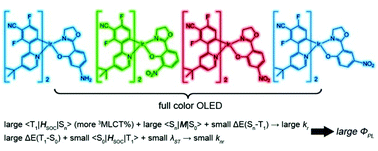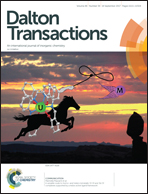From blue to full color – theoretical design and characterization of a series of Ir(iii) complexes containing azoline ligand with potential application in OLEDs†
Abstract
Two reported Ir(III) complexes 1a and 1b containing oxazoline and imidazoline in ancillary ligand, respectively, were investigated by DFT/TD-DFT method. In order to obtain full-color display materials, we designed a group of Ir(III) complexes 2a–3d based on 1a, which exhibits higher quantum efficiency in phosphorescence, by introducing electron-donating/electron-withdrawing moieties to different positions of the ancillary ligand to adjust emission color. In addition to calculating the radiation rate and analyzing its determining factors, we also estimated nonradiative ability by evaluating the spin–orbit coupling matrix element between the ground state (S0) and the lowest triplet state (T1) as well as the reorganization energy from T1 to S0 to estimate quantum efficiency more accurately. In particular, an in-depth analysis on the contribution of each vibration mode to reorganization energy helped us to identify the effect of substituents on the nonradiative process. Besides, charge injection/transfer properties and energy relation of the states related to exciton quenching via the triplet metal-centered state were also examined, which provide an estimation on the OLED performance of our designed complexes. Overall, we expect 2b and 3c to be more efficient blue-emitting emitters than 1a and 3a and 3b to be efficient green and red emitters, respectively.



 Please wait while we load your content...
Please wait while we load your content...